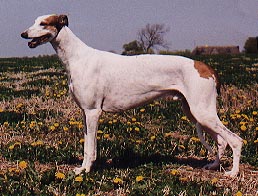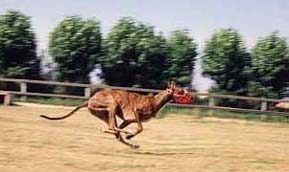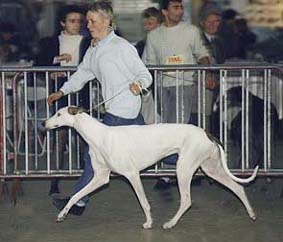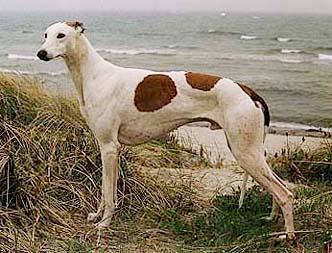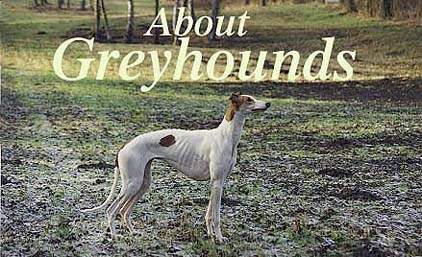 |
|---|
|
Hanne Böckhaus, Kennel Eikica, Torresvej 16, DK-4894 Øster Ulslev, Denmark. www.eikica.dk Tel. +45 (the number for Denmark) 5487 6006. |
|
The origins of the Greyhound go right back through history. Sighthounds are a type of dog that is many thousands of years old, originating in North Africa and the Middle East. Discoveries in Egypt from the years 4000 to 2000 BC show dogs that apparently were not much different from the ones we know today. They were depicted in art in the Roman times. According to the FCI standard for the greyhound-like breed Galgo Español, the Galgo was the forefather to the modern Greyhound by spreading across Europe and ending in Great Britain. The Greyhound as a family dog: Greyhounds are docile, kindly and sweet tempered dogs. They can be a little reserved with strangers, but as puppies they are boisterous, outgoing and happy and not at all like the quiet and elegant adults they will soon grow up to be. |
Greyhounds love to be the centre of attention, talked to and shown plenty of love by the owner. They will take possession of the family's best armchair or sofa - if this is allowed! They love kindly and considerate children and most can, from puppyhood learn to live peacefully together with other animals in the household - even including cats!
|
 Eikica Precious Pagan who went BIS at Myndeklubben's (The Danish Sighthound Club) show at Vilhelmsborg, June 2000. General appearance: The Greyhound is a beautiful combination of strength and elegance. Since they are designed for maximum speed, they are streamlined slim, with a narrow head and intelligent alert expression, small folded ears, a long elegant neck on a muscular body with a slight curve over the back, deep rib cage and good "tuck up". Long legs with very well developed thighs and low hocks culminating in a low set very long tail for giving good balance. They have an effortless gliding movement with an elastic, springy trot. Their coat is silky smooth and fine and comes in all doggie colours or combinations of same! Size and weight varies depending on whether it's a small feminine bitch or a well developed dog, so the height can be from 68 - 76 cm at the shoulder and the weight between 30 - 45 kilos. In later years, the Greyhound has evolved into two more or less distinctive types: The racing dog where breeders take almost no consideration of the animal's looks when breeding, only how fast they can run, and the Show Greyhound where how they run is totally unimportant, but their looks and beauty are on the other hand are alpha and omega. You are welcome to write or ring Hanne Böckhaus, her address is: Torresvej 16, DK-4894 Øster Ulslev, Denmark. |
| Caring for a Greyhound: Greyhounds are easy to care for as their smooth short coat just needs the occasional brushing with a rubber brush and then should be smoothed over with a damp cloth or chamois leather. The dog then shines and you are free of seeing loose hairs around. Occasionally one can bath them in a good quality dog-shampoo. As with all other dogs, nails must be cut regularly and teeth kept clean. They rarely bring dirt into the house and don't smell "doggie". Greyhounds (and Whippets!) always respect if you are busy with something in the home and are happy to just sit quietly beside you - they never run around under your feet and get in the way - they know when they are not wanted and accept this.
A word of warning: Greyhounds, as with other Sighthounds, can be difficult to anesthetize and there are certain dangers attached. Tell your vetinary to take special care, for often they do not require as much anesthetic as ordinary dogs of similar weight. Many have lost their lives at the hands of an inexperienced vet. The joy of owning such a "royal", elegant, sweet natured and loving Greyhound is just as great whether or not you want to go to dog shows, to racing, agility and obedience or just want an adoring companion always to be around you. Greyhounds in Denmark are very few and so we have few "rescue" problems or unwanted puppies. It might interest you to know that it is forbidden in Denmark to sell kittens or puppies in pet shops. This does cut down the number of "impulse purchases" that so many people regret later, plus a good deal of cruelty. Nor is there any "puppy mill" to beware of. If you want a greyhound, you go straight to the breeder - who in many cases, will take the dog back if things don't work out. You can also get heaps of good advice about your Greyhound and it's care and all questions answered in full. You may even become friends for life and many come back another time for one more! - You certainly will if it's Hanne you go to! GO BACK TO CHOOSER where you can re-choose some of the pages again! |
